HLTAAP001 Recognise healthy body systems
Assessment – answer all questions
1. Answer the following questions
I. The auditory nerve is associated with the:
- Eye
- Skin
- Ear
- Nose
II. The olfactory nerve is associated with
- Eye
- Skin
- Ear
- Nose
III. The optic nerve is associated with:
- Eye
- Skin
- Ear
- Nose
IV. The pituitary gland is located in the:
- Eye
- Throat
- Brain
- Foot
V. Adrenaline is secreted from ... :
- Salivary glands
- Adrenal glands
- Brain
- Heart
VI. Which hormone increases blood glucose levels?
- Testosterone
- Adrenaline
- Glucagon
- Oestrogen
VII. What gas is a waste product of respiration?
- Methane
- Carbon Dioxide
- Oxygen
- Helium
2. Match the definition to the word.
| Word | Definition |
| a) Mouth | Food undergoes chemical and mechanical digestion |
| b) Stomach | Externally visible part of the oral canal |
| c) Colon | Extracts salt and water from solid wastes before they are excreted from the body. |
| d) Caecum | Marks the beginning of the large intestine |
| e) Duodenum | Located at the junction of the stomach and the small intestine |
| f) Ileum | Final portion of the small intestine, leads into the large intestine |
3. Answer the following questions.
I. Which organ system consists of skin, hair, nails, and sweat glands?
- a. Endocrine
- b. Integumentary
- c. Respiratory
- d. Lymphatic
II. The function of the ventricles is to:
- Pump blood
- Collect blood
- Transport blood
III. Arteries carry blood:
- To the heart
- Away from the heart
- From the brain
IV. The skeleton protects:
- Joints
- Vital organs
- Muscles
V. What type of muscle is the intestine:
- Voluntary
- Involuntary
VI. An organ is a specialized group of tissues that performs a particular function
- True
- False
4. Answer the following questions.
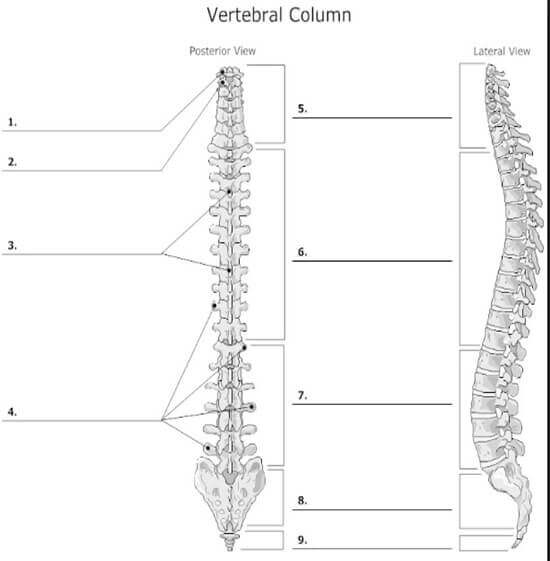
a) What type of vertebrae are number 5?
- Cervical
- Lumbar
- Sacral
- Thoracic
b) What type of vertebrae are number 9?
- Cervical
- Lumbar
- Sacral
- Coccygeal
c) What type of vertebrae are number 6?
- Cervical
- Lumbar
- Sacral
- Thoracic
d) What type of vertebrae are number 7?
- Coccygeal
- Lumbar
- Sacral
- Thoracic
5. What are the three main types of blood cells?
6. Match the structure to the correct
Structure | Various Primary roles | Correct Primary role |
Muscle tissue | a. Helps defend the body against disease | |
GI system | b. Basic unit of body structure and the body’s building blocks | |
Cells | c. Performs the process of digestion and absorption of nutrients and elimination of waste | |
Endocrine system | d. Assists in regulation of body fluids and eliminates waste products | h |
Cardiovascular system |
e. Receives and conducts electro-chemical impulses | |
Nervous tissue | f. Also known as the circulatory system it transports blood, chemicals and nutrients around the body | |
Respiratory system | g. Aids movement through the ability to contract | |
Urinary system | h. a system of glands that secretes hormones | |
Lymphatic tissue |
i. performs gas exchange, allowing uptake of oxygen and elimination of carbon dioxide |
7. In the diagram of the digestive system below fill in the following terms: oesophagus, pancreas, rectum, mouth, liver, large intestine, anus, gall bladder, stomach, small intestine, appendix
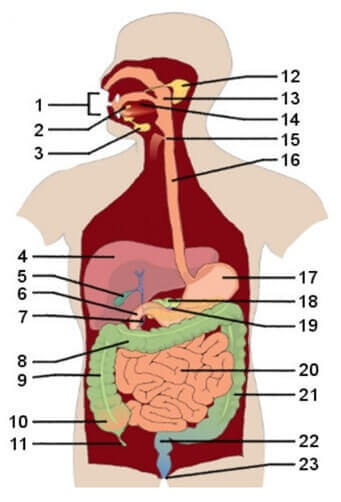
8. In the diagram of the urinary system below fill in the following terms: Bladder, Kidney, Ureter, Urethra
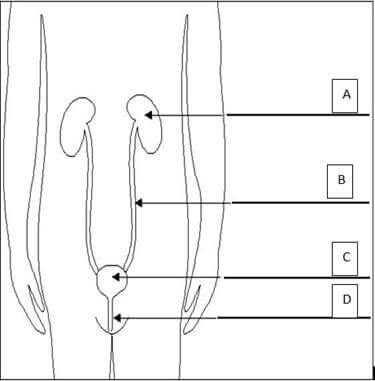
9. In the diagram of the lungs below fill in the following terms:
trachea (windpipe), cardiac notch, diaphragm, larynx, right superior lobe, left superior lobe, right inferior lobe, right middle lobe, bronchial tree, left inferior lobe.
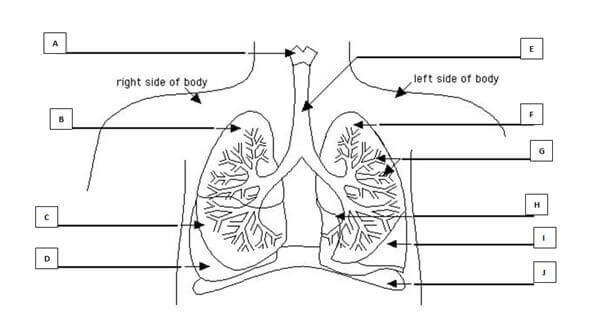
10. In the diagram of the eye below fill in the following terms:
Aqueous Humor, Lens, Pupil, Cornea, Iris, Vitreous Humor, Retina, Optic Nerve
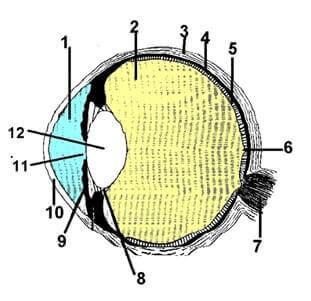
11. Complete the table below about the interrelations between two different body systems. The first one has been done for you.
Body system and function | Body system | Interrelationship |
Cardiovascular: The cardiovascular system is responsible for transporting nutrients, oxygen, and hormones to cells throughout the body. It works in conjunction with the respiratory system to help move oxygen throughout the body. | Integumentary | The cardiovascular system controls sweat production. |
Musculoskeletal system The basic function of the musculoskeletal system is to protect and support the internal structures and organs of the body | Nervous | |
Endocrine The endocrine system is a series of glands throughout the body that secrete chemicals (hormones) into the bloodstream; hormones, in turn, affect body functions. | Respiratory | |
Digestive The function of the digestive system is digestion and absorption. Digestion is the breakdown of food into small molecules, which are then absorbed into the body. | Urinary |
12. Answer True or False
Dehydration occurs when more water and fluids are leaving than entering the body and can lead to headaches and lethargy.
True or False
Electrolytes balance in our bodies is NOT essential for normal function of our cells and our organs.
True or False
High blood Pressure is also known as Hypotension
True or False
13. Make a list of the (7) things that should be considered in terms of the maintenance of a healthy body.
14. Answer True or False.
A person’s physical health CAN influence their state of mind
True or False
People who are unwell or experiencing poor health, CAN experience mental illness.
True or False
15. Answer True or False.
A health worker understands the basic fundamentals of maintaining a healthy body so they can recognise poor health in their client
True or False
Simple changes in such as different food, exercise, dehydration or stress can be recognised by the health worker
True or False
16. Complete the table below with information about the function of each of the special senses.
Special sense | Function |
Vision | |
Hearing | |
Smell | |
Taste | |
Equilibrium |
17. Give six (6) examples of disorders/disease that may affect the nervous system
18. Give four (4) examples of disorders/disease that may affect the respiratory system
19. What is osteoporosis and how common is it?
20. What is colorectal cancer?
21. Complete the table below by providing an example of each.
Component | Example |
Cells | |
Tissue | |
Organs |
22. Describe (3) three ways that you can protect against the spread of infections.
23. Case Study 1
Read the following case study and answer the question.
Mrs Wheeler is an active 60 year old woman who has moved in to a hostel unit in an aged care facility due to extreme arthritis in both her knees. Lively and articulate, she expresses her concern about the impact this situation will have on her life.
Mobility problems can be debilitating for a person with a disability and lead to secondary problems such as respiratory diseases, osteoporosis and chronic constipation. Mobility issues may also impact on social functioning leading to increasing dependence on formal supports, and further restrictions on accessing facilities and activities available in the community.
- What body system(s) does her condition mainly affect?
- What signs and symptoms result from this?
- Describe two (2) secondary social problems that may result in this condition.
- What lifestyle change or modifications would Mrs Wheeler benefit from?
- What is your role in supporting the individual with these changes?
24. Case Study 2
Read the following case study and answer the question.
Joe has suffered bruising on his leg as a result of a workplace accident. He does not leave the house and spends a lot of time reflecting on the accident.
- What body systems e.g. circulatory, nervous, respiratory, are involved?
- How can this impact on other body systems in Joe? (minimum 50 words)
- If you were Joe’s support worker explain in detail how could you assist him? (minimum 75 words)
25. Case Study 3
Read the following case study and answer the question.
Franco is a support worker for ‘Assist Home Care’. He visits Mrs Hoskings twice a week to assist with basic household tasks. Mrs Hoskings complains of the following:
- Constant colds
- Muscle weakness
- Bone pain
She states that this has resulted in her becoming more house-bound
- List the systems that are contributing to Mrs Hosking’s health problem
- What would you do as Mrs Hosking’s support worker (minimum 75 words)
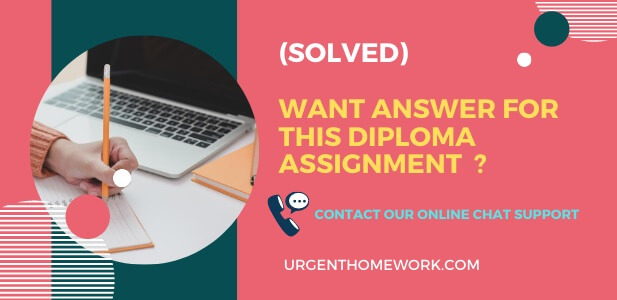
Diploma Courses in Australia
- ACC203 Management Accounting
- ACC703 Accounting Information
- BSB61015 Advanced Diploma of Leadership
- BSB60515 Advanced Diploma of Marketing
- BSBADM502 Manage Meetings
- BSBADM502 Manage Meetings Answers
- BSBADM506 Manage business document design
- BSBCOM603 Plan and establish compliance management
- BSBFIM601 Manage Finances Prepare budgets
- BSBFIM601 Manage Finances Monitor and review budget
- BSBHRM509 - MANAGE REHABILITATION OR RETURN
- BSBHRM512 develop and manage performance
- BSBINM601 Manage knowledge and information
- BSBINN601 Lead and manage organisational change Task 1
- BSBINN601 Lead and manage organisational change Task 2
- BSBINN601 Lead and Manage Organisational Change Task 2
- BSBINN601 Lead and manage organisational change Task 3
- BSBMGT403 Assessment Answers
- BSBMGT502 Assessment 1
- BSBMGT502 Assessment 2
- BSBMGT502 Assessment 3
- BSBMGT502 Assessment 4
- BSBMGT517 Assessment 2 - Operational Plan
- BSBMGT517 Manage Operational Plan Assignment Answers
- BSBMGT605 Provide leadership across the Organisation T1
- BSBMGT605 Provide leadership across the Organisation T2
- BSBMGT605 Provide leadership across the Organisation T3
- BSBMGT605 Provide leadership across the Organisation T4
- BSBMGT608 Manage innovation and continuous
- BSBMGT616 Develop and implement strategic plans
- BSBMGT617 Develop and Implement A Business Plan
- BSBMGT624 Develop and implement corporate social
- BSBMKG502 Establish and adjust the marketing mix
- BSBMKG609 Develop a marketing plan
- BSBPMG505A Manage Project Risk
- BSBPMG505A Manage Project Quality
- BSBRSK501 Manage Risk Answers
- BSBSUS501 Develop workplace policy
- BSBSUS501 Develop workplace policy and procedures
- BSBSUS501 Develop workplace policy and procedures
- BSBSUS501 Develop workplace policy and procedures
- BSBWHS605 Develop, implement and maintain WHS
- BSBSUS501 Develop workplace policy and procedures
- BSBWRK510 Business Services Training Package
- BSBWRK510 Manage employee relations
- BUS707 – Applied Business Research
- BMA583: Managing People and the Employment
- CHCAGE001 Facilitate the empowerment of older people
- CHCAGE002 Implement falls prevention strategies
- CHCAGE005 Provide support to people living with dementia
- CHCCCS011 Meet personal support needs
- CHCCCS015 Provide individualised support
- CHCCCS015 Provide individualised support Assessment
- CHCCCS023 Support independence and well being
- CHCCOM005 Communicate and work in health
- CHCDIV001 Work with diverse people Assessment
- CHCLEG001 Work legally and ethically Assessment
- CHCPAL001 Deliver care services using a palliative approach
- CHCPOL003 Research and apply evidence to practice
- CHCDIS002 Follow established person-centred behaviour
- CHCDIS003 Support community participation and social
- CHCDIS007 Facilitate the empowerment of people with
- CHCDIV001 Work with diverse people
- CHCLEG001 Work legally and ethically
- CHCLEG001 Work legally and ethically Learner Guide
- CHCLEG001 Work legally and ethically Learner Workbook
- CHCWHS312A Follow WHS safety procedures for direct care
- CPCCBC5011A Develop and Implement an Environmental
- CPCCBC5011A Manage Environmental Management Practices And Processes In Building And Construction
- CPCCBC5003A Construction Project Planning
- CPCCBC5018A Apply structural Principles Medium rise
- HLTAAP001 Recognise healthy body systems Assessment
- HLTAAP001 Recognise healthy body systems
- HLTAAP001 Recognise healthy body systems Case Study
- HLTAAP001 Recognise healthy body systems Learner Guide
- HLTAAP001 Recognise healthy body systems Learner
- HLTWHS002 Follow safe work practices for direct client care
- HLTWHS002 Follow safe work practices for direct client care
- HLTWHS002 Follow safe work practices for direct client care
- HLTWHS002 Follow safe work practices for direct client care
- Manage project risk
- MITS5002 Software Engineering Methodology
- MKT01907 Tourism And Hospitality Management
- SHBXWHS001 Apply safe hygiene, health and work practices
- SITHKOP002 Plan and cost basic menus Learner Guide
- SITHKOP002 Plan and cost basic menus Learner Workbook
- SITHKOP006 Plan Catering for events or Functions
- SITXCCS007 enhance customer service experiences
- SITXCCS007
- SITXHRM003 Lead and manage people
- SITXINV004 Control stock
- SITXFIN003 - MANAGE FINANCES WITHIN A BUDGET

